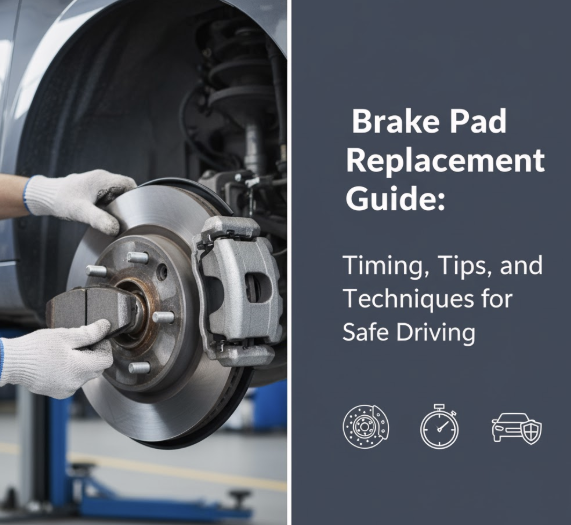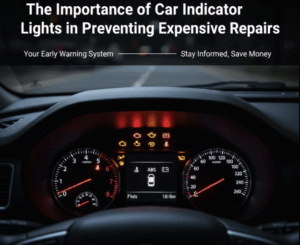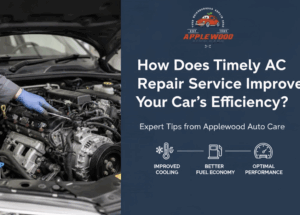Your vehicle’s braking system is one of the most critical components for your safety on the road. At the heart of this system are your brake pads, the friction material that ensures your car stops efficiently. Over time, these pads wear down, and replacing them at the right time is essential to prevent costly repairs and maintain smooth, reliable stopping power.
This guide covers everything you need to know about brake pad replacement, including timing, tips, and techniques to keep your vehicle safe and performing at its best.
Table of Contents
Toggle1. Understanding Brake Pads and Their Role
Brake pads work by creating friction against the brake rotors whenever you press the brake pedal. This friction slows the rotation of the wheels, allowing your car to stop. The pads are designed to wear down gradually, which is normal, but ignoring them can cause damage to rotors, calipers, and even other parts of your braking system.
Different types of brake pads include:
- Organic pads: Affordable and quiet but wear faster.
- Semi-metallic pads: Durable and good for heavy-duty driving.
- Ceramic pads: Longer-lasting, quiet, and ideal for most modern vehicles.
Choosing the right type for your driving habits can significantly impact longevity and braking performance.
2. When to Replace Your Brake Pads
Knowing when to replace brake pads is crucial for maintaining vehicle safety. Signs that indicate it’s time for replacement include:
- Squealing or squeaking noises when braking
- Grinding sounds signaling metal-on-metal contact
- Increased stopping distance
- Vibrations through the brake pedal
- Dashboard alerts or car warning symbols related to brake performance
Most brake pads last between 30,000 and 70,000 miles, depending on driving style, vehicle type, and pad material. Regular inspections every 10,000–15,000 miles are recommended to monitor wear and prevent unexpected issues.
3. Steps for Safe Brake Pad Replacement
Replacing brake pads is a technical task that requires proper tools and knowledge. Here’s a step-by-step guide for safe and effective replacement:
Step 1: Gather Tools and Materials
You’ll need:
- Jack and jack stands
- Lug wrench
- C-clamp or brake piston tool
- Socket set
- New brake pads
- Brake grease or anti-squeal compound
Step 2: Lift the Vehicle
Use the jack to raise the car and secure it with jack stands. Always ensure the car is stable before working underneath.
Step 3: Remove the Wheels
Take off the lug nuts and remove the wheels to access the braking system.
Step 4: Remove Old Brake Pads
- Locate the caliper and remove the bolts.
- Slide out the old pads carefully.
- Check the rotors for damage; resurfacing or replacement may be necessary.
Step 5: Install New Pads
- Apply brake grease to the backing plate to reduce noise.
- Insert the new pads into the caliper bracket.
- Compress the caliper piston using a C-clamp before securing the caliper.
Step 6: Reassemble
- Reattach the wheels and tighten the lug nuts.
- Lower the vehicle carefully.
- Pump the brakes gently to seat the pads properly.
Step 7: Test Drive
Drive at low speeds initially to ensure smooth braking and check for unusual noises or vibrations.
For drivers uncomfortable with DIY repairs, visiting a trusted repair shop in Lakewood can ensure professional service and peace of mind.
4. Tips for Extending Brake Pad Life
Proper maintenance can extend the life of your brake pads:
- Avoid hard braking whenever possible. Smooth stops reduce heat buildup and pad wear.
- Inspect pads regularly, even between major maintenance intervals.
- Keep the braking system clean; debris can accelerate wear.
- Rotate tires regularly to maintain even braking force.
- Address related vehicle issues like suspension repair, as worn suspension parts can cause uneven brake pad wear.
5. The Connection Between Brake Maintenance and Overall Vehicle Health
Brake pad replacement isn’t just about stopping power — it also affects other parts of your vehicle:
- Rotors and calipers: Worn pads can damage rotors and calipers, increasing repair costs.
- Suspension system: Uneven braking forces can strain shocks and struts.
- Engine performance: In rare cases, prolonged brake drag can impact fuel efficiency, highlighting the importance of routine checks alongside engine tune-ups.
- Cabin comfort: Faulty brakes can lead to vibrations and noises that reduce overall driving comfort.
Ensuring brakes are properly maintained complements other routine services like auto AC repair, keeping your vehicle running safely and efficiently.
6. Choosing the Right Brake Pads
Selecting the correct brake pads for your vehicle involves considering driving habits, climate, and vehicle type. Ceramic pads are ideal for everyday commuting and quieter operation, while semi-metallic pads are better for towing, heavy loads, or mountainous regions. High-performance or sports vehicles may require specialized pads to handle heat and stress.
Consult your vehicle’s manual or a professional at a trusted repair shop in Lakewood to ensure you choose the best option.
7. Cost of Brake Pad Replacement
The cost of replacing brake pads can vary:
- Standard pads: $150–$250 per axle
- Premium pads (ceramic or high-performance): $250–$400 per axle
- Labor costs: $80–$150 per hour depending on location and complexity
Additional repairs, like rotor replacement or suspension repair, may increase costs. Investing in quality service upfront saves money on more expensive repairs down the road.
8. Common Mistakes to Avoid During Brake Replacement
- Using incorrect or cheap pads
- Failing to check rotor condition
- Not properly seating the caliper piston
- Ignoring signs like vibrations, squealing, or dashboard car warning symbols
Correcting these mistakes ensures smooth braking and prevents costly repairs later.
9. Benefits of Professional Service
While DIY brake replacement is possible, professional service ensures:
- Proper pad installation
- Inspection of related components like calipers, rotors, and brake fluid
- Detection of issues like worn suspension or brake line leaks
- Peace of mind with warranty coverage
A trusted repair shop in Lakewood offers certified technicians who can handle these tasks efficiently and safely.
10. Summary
Brake pads are a vital component of your vehicle’s safety system. Knowing when to replace them, how to maintain them, and when to seek professional help ensures safe driving and protects your investment. Proper maintenance complements other vehicle care services like engine tune-ups, suspension repair, and auto AC repair, keeping your car running smoothly and efficiently.
Regular inspections, timely replacement, and professional guidance will help you avoid accidents, reduce repair costs, and enjoy confident driving every time.
FAQs About Brake Pad Replacement
- How often should I replace my brake pads?
Most brake pads last 30,000–70,000 miles, but frequent inspections every 10,000–15,000 miles are recommended. - Can I replace brake pads myself?
Yes, with proper tools and knowledge. However, professional service is safer and ensures all components are properly inspected. - What happens if I ignore worn brake pads?
Ignoring worn pads can damage rotors, calipers, and suspension components, leading to costly repairs and reduced braking efficiency. - How can I tell if my brake pads are wearing unevenly?
Signs include vibrations, pulling to one side when braking, or unusual noises. Regular inspections catch uneven wear early. - Are premium brake pads worth the cost?
Premium pads, like ceramic or high-performance pads, last longer, reduce noise, and provide better braking performance, making them a worthwhile investment for many drivers.









